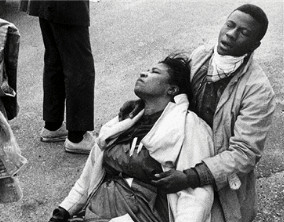
Amelia Boynton Robinson was born in Savannah, Georgia, in 1911, one of 10 children. Her family emphasized the importance of service to others, and she was raised in a home where church, biblical foundations, and education were of great importance. Mrs. Robinson started her college education at Georgia State College (now Savannah State). After two years, she transferred to Tuskegee Institute (now Tuskegee University) in Tuskegee, Alabama, where she earned a degree in home economics.
After two teaching positions in Georgia, Mrs. Robinson accepted a position with the U.S. Department of Agriculture (USDA) in Selma, Alabama, as a home demonstration agent for Dallas County. In this role, she traveled throughout the county teaching residents about food production, preservation, nutrition, and healthcare.
While working for the USDA, she met and married her husband, Samuel William Boynton, who was the county extension agent. Together they served their community by teaching and training residents about agricultural methods, voting rights, property ownership, and the importance of education.
For over 30 years, she worked tirelessly to help African Americans to register to vote. In 1963, Robinson’s husband died, but she remained steadfast in her commitment to voter registration and invited Dr. Martin Luther King Jr. and the leadership of the SCLC (Southern Christian Leadership Conference) to come to Selma to assist with getting the right to vote for African Americans. Robinson helped to organize and lead the Selma to Montgomery March on March 7, 1965 which became known as “Bloody Sunday.” The photos taken of her, Congressman John Lewis, and other marchers on the Edmund Pettus Bridge being gassed and beaten helped to bring national and international attention to the civil rights movement.


In later life, Robinson returned to Tuskegee and worked relentlessly for human and civil rights throughout the nation and the world. In 2015 she was recognized by President Barack Obama for her role in the Selma to Montgomery March in his State of the Union Address. Upon her death in August 2015, just months after marching with her and Congressman John Lewis across the Edmund Pettus Bridge to mark the 50th anniversary of the Selma to Montgomery March, President Obama said, “Amelia Boynton Robinson was a dedicated and courageous leader in the fight for civil rights. For most of her 104 years, Amelia committed herself to a simple, American principle: That everybody deserves the right to vote. Fifty years ago, she marched in Selma, and the quiet heroism of those marchers helped pave the way for the landmark Voting Rights Act. But for the rest of her life, she kept marching-to make sure the law was upheld, and barriers to the polls torn down.”
Want to Know More?
- Watch a one minute Legacy Moment Amelia Boynton Robinson from Alabama Public Television here.
- Primary source photographs: Scene at the foot of the Edmund Pettus Bridge in Selma, Alabama after the civil rights marchers were beaten and gassed by Alabama state troopers and Dallas County deputies on Bloody Sunday. (Mrs. Robinson is being assisted by others to stand.)
- Check out this article from the Encyclopedia of Alabama.
- Hear Amelia Boynton Robinson tell the story of “Bloody Sunday” on StoryCorps Atlanta.

